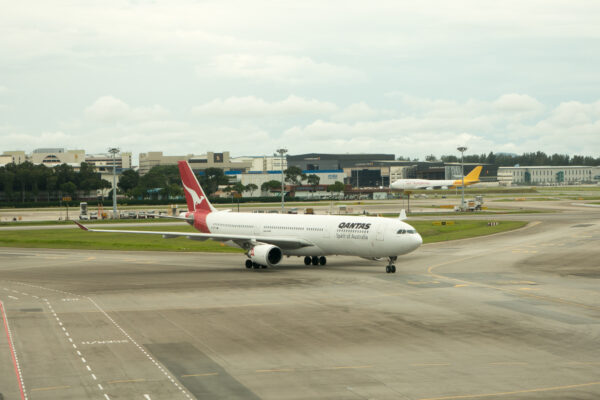
Among the couple of jobs I had dreamed to do, when I was a child, one of them was to be a pilot. I ended up doing something else. But I’ve always had a fascination with flying, and am what you could say an armchair pilot. For others who are also fascinated about flying a passenger aircraft, this entry in Quora is an interesting read.
Flying an aircraft is complex. I don’t mean to downplay, say, a single turboprop engine Cessna, but a large passenger aircraft is certainly a beast of another level. Cockpits that were once filled with a vast array of analog instruments, like this one of a Lockheed SR-71 Blackbird, are now giving way to digital avionics and computerised systems.
Even if you’re not particularly interested to know about what’s in the cockpit, do at least skim through the Quora entry (the repost on Gizmodo might be easier to read). It’s quite overwhelming. You’re only being pointed out the various controls and instruments, not so much about how to use them, what are they used for, or why are they needed. It’s merely an enumeration of all the things there are to see in a cockpit, in this case, that of a Boeing 737-600.
Of course, training to be a pilot is an intensive course in itself, not anything comparable to learning to drive a car. There are two parts about learning to fly an aircraft. The first is about the principles of flight, and how to fly. This is about flying itself. The other part is about learning to use this very complicated flying machinery.
The second part has become rather complicated. Automation and computerised systems are supposed to make things a lot less complicated. But, in fact, they are also part of the complexity problem.
Aircrafts crash for many reasons. Of course, you might have heard that the fatalities statistics favour flying over other forms of transport. Still, there are accidents, and some resulting in fatalities. There are many reasons for these fatal accidents. Do you know, pilot errors make up the top reasons of fatal accidents?
According to http://www.planecrashinfo.com/cause.htm, in the 2000s decade, 53 fatal accidents were due to pilot errors, more than all other reasons put together (weather, mechanical failure, sabotage, and other causes).
If you are an ardent follower of documentary series like Air Crash Investigations, you’ll learn that in many of the pilot error situations, there was a disjoint between pilot and machine. In other words, the pilots did not know what the aircraft was doing, or what the aircraft was not doing. For example, they thought the auto-pilot was engaged when in fact they had inadvertently disengaged auto-pilot without knowing it.
When I first drove a car with cruise-control, I was very apprehensive about how that feature worked. I spent time figuring out how to interact with it, how I could override it (while it was engaged), how to determine if it was doing what I thought it should be doing, etc. It was a rental car I drove while in the U.S. Eventually, on that long drive, I gave up and did without cruise control.
This is, of course, not comparable with flying an aircraft costing hundreds of millions of dollars. But I still think this is a big problem. Aircrafts have become so complex, I think the pilots don’t always know well enough how the magic works. Like really, deeply, understand.
It’s like with people who drive cars, just how much of the cars they’re driving do they understand? Alright, that’s not quite a fair comparison. But the point is that it’s not totally surprising for people to not totally and deeply understand the magic that they’re working with.
On the other hand, those magic have become quite necessary. The automation is needed, otherwise it becomes very tedious, and complicated in a different way, to fly an airplane. An interesting problem we’ve gotten ourselves in. You need computerised systems. But computerised systems are not infallible, nor are they always completely understood by people.
AirAsia QZ8501’s crash at the end of 2014 brought back memories of the Air France Flight 447 in 2009. The latter had crashed due to pilot error, triggered by bad weather and faulty instruments. The pilots were unable to understand the system. They were disoriented. The pilots didn’t even know what each other were doing. They lost situation awareness.
It may be a little premature to speculate about the cause of QZ8501’s misadventure. However, I tend to think pilot error had played a part.
The reason is this. The modern aircraft is very advanced, with plenty of redundancies and fault tolerance. Instruments can fail. Systems can fail. An engine even exploded on Qantas Flight 32 from Singapore. But in the case of Qantas Flight 32, the aircraft landed safely thanks to the superb handling of the situation by the flight crew. Ultimately, humans will think through the problems, and they will make things right. Machines can fail, but humans will work around them.
There’s an issue with many aircraft crashes in that they tend to have a subjective slant to the investigation and reporting. Take the case of Singapore Airlines Flight 006 which crashed during take-off in Taiwan in 2000. The Boeing 747 had lined up on an incorrect, disused runway, and crashed into construction equipment parked on it. The reporting in Singapore made it look like the airport was (at least partly) to blame. When I discuss this with friends, that’s what they think too. But the facts are really straight-forward. The flight crew failed to positively identify the runway they were on. They failed to check their navigation instruments.
I used to work in an air base. It may come across as shocking to others, but it’s usually not the tower’s responsibility to check and ensure that you are where you are supposed to be. It is usually not their job. The people on the ground, it is their responsibility to go where they are told to go, and to make sure they got to the right place.
After accidents like these, we’ll always talk about bringing in technology to make sure these mistakes don’t happen, to prevent such future mistakes from repeating.
Are we ever going to make our computerised systems so clever that thinking humans aren’t needed anymore? I’m not sure if that’s a very great idea. But indeed, it seems we are going that way, like with aircrafts that can fly themselves.
Some day, aircrafts will fly themselves. The technology is already there, though we still have pilots who, to varying degrees, prefer to actually fly the plane at least some of the time. A car can just stop on the road if something breaks down. An aircraft, unfortunately, cannot just stop in-flight. We need technology to assist pilots, but not to replace them. Furthermore, we need pilots to be totally completely understand the aircraft they are handling. You don’t ever want to hear a pilot say, while flying in mid-air, “hold on a minute, let me figure out what is going on.”

View Comment Policy